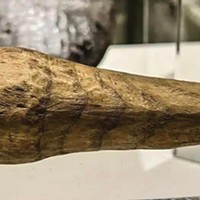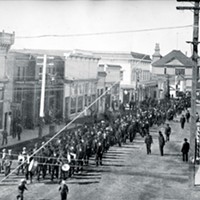[
{
"name": "Top Stories Video Pair",
"insertPoint": "7",
"component": "17087298",
"parentWrapperClass": "fdn-ads-inline-content-block",
"requiredCountToDisplay": "1"
}
]
"Oh how much I want you at my birthday party. You'll make the day so much more fun. I do hope you can make it."
— Letter from Claudia Severa to her sister Sulicia Lepidina, wife of Flavius Cerialis, prefect of a cohort stationed at Vindolanda fort, circa A.D. 100.
This birthday invitation, written on a thin wooden tablet in what is now Northern England, may be the oldest surviving writing in Latin by a woman. Thanks to being preserved intact beneath thick layers of mud, it is one of hundreds of handwritten documents found at Vindolanda Fort, illuminating life on the frontier of the Roman Empire nearly 2,000 years ago. Most of these thin, postcard-sized tablets are now in the British Museum in London, where they were voted Britain's Top Treasure.
The Romans conquered most of Britannia in the years following Emperor Claudius' invasion of A.D. 43. In the north, where Pict tribes fiercely resisted the incursion, Roman legionnaires built a series of forts, first out of wood and, later, stone. One of the most important of these was Vindolanda, established around A.D. 85, sited midway between present-day Carlisle and Newcastle in Northumbria. About 40 years later, Emperor Hadrian ordered the construction of a 72-mile-long wall across the width of the country as a defense against the Picts and to control trade between local tribes. Hadrian's Wall, originally 16 feet high (now much reduced after centuries of pillaging for local buildings) runs just north of Vindolanda Fort.
The first of the Vindolanda tablets was unearthed during an archeological dig in 1973. Thought at first to be two wood shavings stuck together, when peeled apart the inside revealed writing that quickly faded in the air. However, infrared photography made the ancient script visible again. Since then, nearly 1,000 similar tablets have been found and deciphered, with more being found every year.
The messages, written in cursive Latin script on slivers of birch or alder, reflect the writers' day-to-day concerns: military matters (Can the surveyor Crispus please have a lighter military service?), requests for provisions (My fellow soldiers have no beer ... please order some to be sent), commercial demands (Make sure you send me some cash so that I may have ears of grain on the threshing room floor) and personal notes (I have sent you ... pairs of socks, two pairs of sandals and two pairs of underpants).
The British Museum has loaned nine of the tablets back to the Vindolanda Museum, where curious visitors like myself can view them in the "vault" and be transported back to when the site bustled with hundreds of garrison troops from all over the empire, along with their commanders (some of whom brought their families), local farmers and shopkeepers. The fort and its adjacent village thrived for hundreds of years, only to be deserted some time after the last of the Roman legions left Britain in A.D. 411.
Starting with amateur archeologists in the 19th century, Vindolanda has come to life again — especially with the discovery of its tablets, each of which gives us a glimpse into life on the frontier of Imperium Romanum, the Roman Empire. The timeless quality of these messages — a mother worrying about her son staying warm, a commander trying to get beer for his men, Claudia's birthday invite — cuts through the centuries and makes their world ours.
Barry Evans (he/him, [email protected]) still wonders why he had to learn Latin at school.
Speaking of...
-

A Brief History of Dildos
Apr 11, 2024 -

Humboldt Bay Timeline
Oct 12, 2023 -

Chinese Again in Humboldt, Part Three
May 25, 2023 - More »
more from the author
-
A Brief History of Dildos
- Apr 11, 2024
-
Eclipse!
- Mar 28, 2024
-
The Little Drone that Could
- Mar 14, 2024
- More »
Latest in Field Notes
Readers also liked…
-
Trouble on the Line: The Reality Part 2
- Nov 3, 2022

































